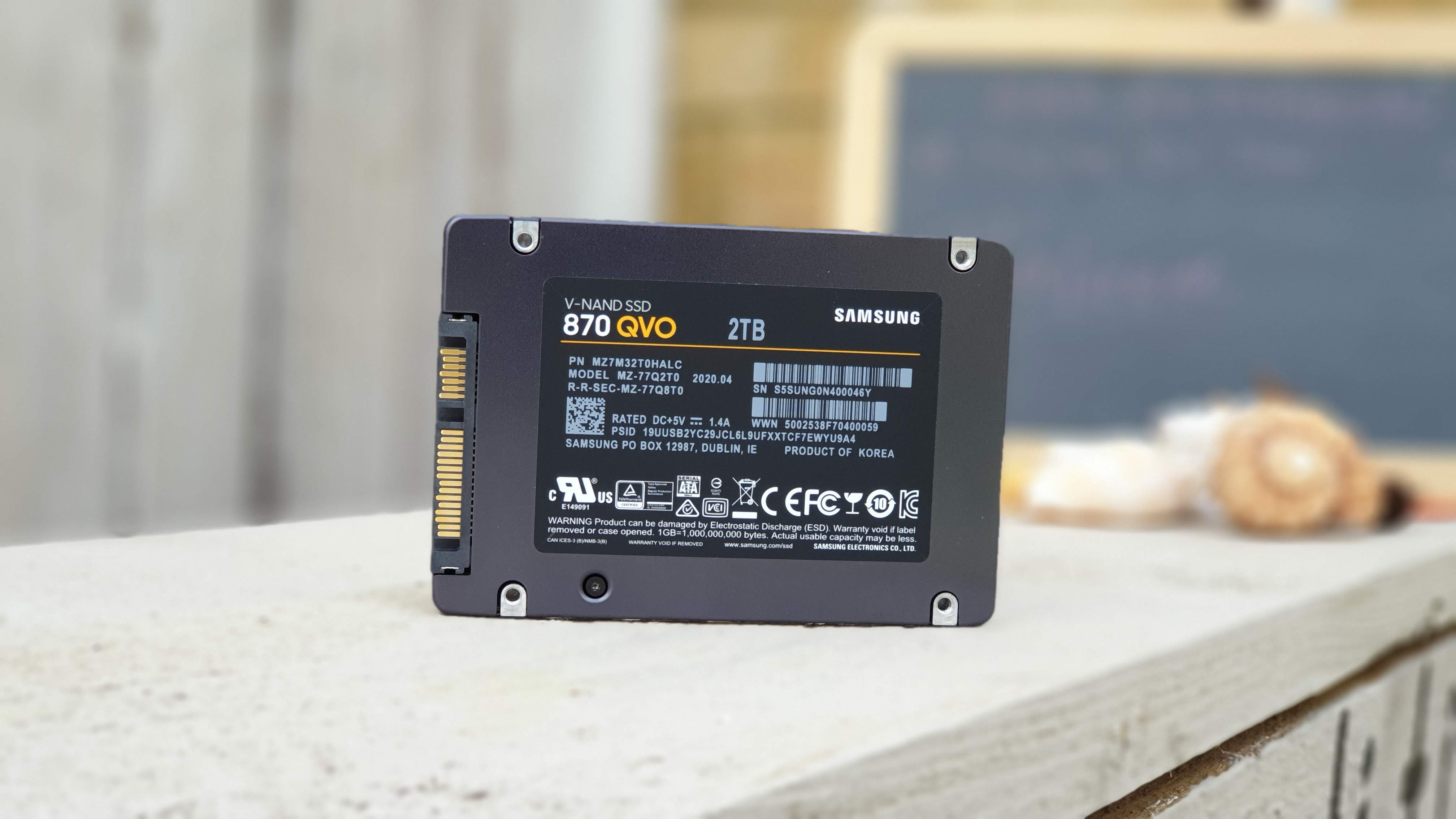Just over 18 months after it was introduced, the 860 QVO is making way for the 870 QVO. The second iteration of Samsung’s popular budget line has upped the ante with the introduction of an 8TB solid state drive, the first time we’ve seen this capacity hit mainstream.
The drive is available in four versions: 1TB ($129.99), 2TB ($249.99), 4TB ($499.99) and finally 8TB ($899.99). It’s worth noting that buying a pair of 2TB SSD costs roughly the same as the 4TB one.
The hardware
The 870 QVO uses Samsung’s second generation 4-bit MLC V-NAND paired with the new MKX controller. The 2TB model we tested today has a 2GB LPDDR4 which is used as DRAM cache memory. The memory size grows proportionally with the SSD capacity. As expected, the device runs on a SATA interface which is somewhat of a disappointment and limits the expected performance of the product.

Sadly, despite our best efforts, we couldn’t pry the case open to check the motherboard. It’s worth noting that the drive weighs in at 46g which is significantly lighter than the 62g of the 860 QVO. What it means is that the SSD is likely to be mostly empty space with the 2.5-inch enclosure needed for compatibility with existing systems.
The software
The 870 QVO ships with Samsung's latest iteration of its Magician SSD toolbox, a suite of useful applications that allows you to update the drive’s firmware, enable encryption options, monitor the health of the SSD and more. Samsung also offers a Data Migration software, which enables the user to clone over data from an existing drive to the new SSD via a “custom cloning” feature.
Note that the drive also supports a number of security features like AES 256-bit (Full Disk Encryption), TCG/Opal V2.0 and Encrypted Drive (IEEE1667).
Performance
The Samsung SSD 870 QVO is rated at 560MBps and 530MBps respectively on sequential read and write. Samsung caveats the latter number by adding that the numbers are based on its Intelligent TurboWrite technology; the latter is a fixed amount of SLC buffer (42GB in the 1TB model, 78GB on the others).
Benchmarks
Here’s how the Samsung SSD 870 QVO performed in our suite of benchmark tests:
CrystalDiskMark: 561.12MBps (read); 530.2MBps (write)
Atto: 537MBps (read, 256mb); 509MBps (write, 256mb)
AS SSD: 502.25MBps (seq read); 483.7MBps (seq write)
AJA: 486MBps (read) ; 466MBps (write)
Once the buffer is full or if the SSD has less than a certain amount of free storage, Intelligent TurboWrite will not work and sequential write performance can fall to as low as 80MBps for the 1TB model and 160MBps for the bigger capacities. Random reads and writes (QD1) are rated at 11K IOPS (a 13% improvement on the 860 QVO) and 35K IOPS.
The drive comes with a three year warranty and has an endurance of 0.33 drive writes per per day (that’s 720TB in total) which is similar to the 860 QVO.
As for the benchmarks, no surprise there: the 870 QVO performs admirably for what it is, a SATA-based SSD. It does hit the quoted numbers under CrystalDiskMark with sequential read speeds of 561MBps/530MBps respectively in read/write using our test system (the Chuwi GBox). Numbers for AJA, ATTO and AS SSD benchmarks were equally impressive but bear in mind that this is a fraction of what PCIe NVMe models can achieve.
The competition
There’s two sides to this: First, the 8TB version. Surprisingly, there is competition at this capacity but not from the usual suspects (Sandisk, Seagate, Sabrent or Kioxia). No, the Micron 5210 ION SSD is an enterprise solid state drive which has been around for nearly two years and has, until now, offered some of the cheapest prices per TB prices on high capacity SSD.
At the time of writing, its highest capacity (7.68TB) can be purchased for $879 from Amazon, which is slightly more expensive per TB compared to Samsung’s 8TB model ($114.45 vs $112.50). It is also slower than its rival but has a longer warranty (five years), a far, FAR higher DWPD (drive write per day) at 0.8 and a Total Byte Written that exceeds 1.1PB (that’s Petabyte).
Micron introduced it as a replacement for large 10K RPM hard disk drives that populate data centers and as such is geared towards those use cases. No surprises here that it uses Micron’s own 3D QLC NAND.
The competition at the lower capacity points is even fiercer; At 4TB, Samsung’s own 860 QVO, by no means a slouch, can be had for $449, Sandisk’s Ultra, for $449.99 - in both cases 10% discounts - while WD Blue hits $527.46 but uses TLC rather than QLC. At 1TB and 2TB, Samsung faces more competition and is likely to be at a disadvantage as faster PCIe NVMe models come down in price rapidly.
Final verdict
We are excited about the 8TB version of the Samsung SSD 870 QVO, less so about the others. Given the current trend, we can expect the next generation, probably called the Samsung SSD 880 QVO to reach 16TB in about two years, which would put it on equal footing with hard disk drives, which are currently at this capacity and very unlikely to grow well beyond that over the next 24 months.
For the other storage tiers though, there’s hardly anything worth getting excited about given the small performance gain over the 860 QVO. Performance is in line with what is expected of a SATA drive and we’ve reached a point where a PCIe NVMe drive, which is capable of achieving far better numbers doesn’t cost a lot more than this one (and is likely to use non-QLC parts).
- We've also highlighted the best SSD
from TechRadar: Technology reviews https://ift.tt/2Vxk9Bk
No comments:
Post a Comment